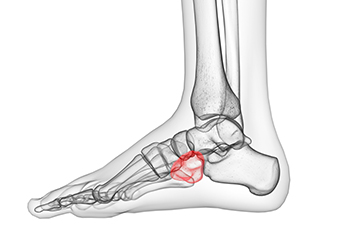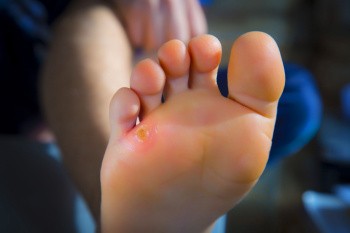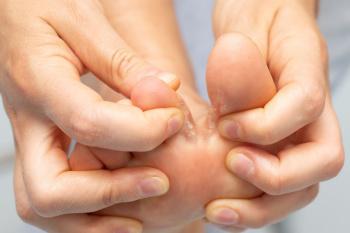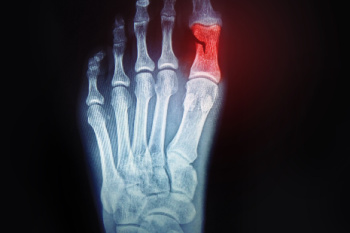Connect With Us
Blog
Items filtered by date: February 2025
Causes and Diagnosis of Cuboid Syndrome

Cuboid syndrome occurs when the cuboid bone in the foot becomes partially dislocated or misaligned, leading to pain and discomfort. This bone is located on the outer side of the foot, and misalignment can result from repetitive stress, ankle sprains, or sudden twisting motions. Common symptoms include pain on the outside of the foot, difficulty walking, and a feeling of instability when standing. The pain may worsen with physical activity or pressure exerted on the foot. Diagnosing cuboid syndrome often involves a physical examination by a podiatrist, who may manipulate the foot to check for tenderness or abnormal movement of the cuboid bone. X-rays or other imaging tests may also be used to rule out other conditions and confirm the diagnosis. If you have pain on the outside of your foot, it is suggested that you consult a podiatrist who can determine the cause and provide treatment.
Cuboid syndrome, also known as cuboid subluxation, occurs when the joints and ligaments near the cuboid bone in the foot become torn. If you have cuboid syndrome, consult with one of our podiatrists from New Jersey. our doctors will assess your condition and provide you with quality foot and ankle treatment.
Cuboid syndrome is a common cause of lateral foot pain, which is pain on the outside of the foot. The condition may happen suddenly due to an ankle sprain, or it may develop slowly overtime from repetitive tension through the bone and surrounding structures.
Causes
The most common causes of cuboid syndrome include:
- Injury – The most common cause of this ailment is an ankle sprain.
- Repetitive Strain – Tension placed through the peroneus longus muscle from repetitive activities such as jumping and running may cause excessive traction on the bone causing it to sublux.
- Altered Foot Biomechanics – Most people suffering from cuboid subluxation have flat feet.
Symptoms
A common symptom of cuboid syndrome is pain along the outside of the foot which can be felt in the ankle and toes. This pain may create walking difficulties and may cause those with the condition to walk with a limp.
Diagnosis
Diagnosis of cuboid syndrome is often difficult, and it is often misdiagnosed. X-rays, MRIs and CT scans often fail to properly show the cuboid subluxation. Although there isn’t a specific test used to diagnose cuboid syndrome, your podiatrist will usually check if pain is felt while pressing firmly on the cuboid bone of your foot.
Treatment
Just as the range of causes varies widely, so do treatments. Some more common treatments are ice therapy, rest, exercise, taping, and orthotics.
If you have any questions, please feel free to contact our office located in Neptune City, NJ . We offer the newest diagnostic and treatment technologies for all your foot care needs.
Are Bunions Affecting Your Everyday Life?
Why Your Feet Fight Back by Developing Corns

Corns are your feet’s defense mechanism against constant friction and pressure. These keratotic lesions form when the skin thickens to protect itself, often appearing on toes or pressure points where shoes rub the wrong way. What starts as a slight discomfort can turn into painful, hardened spots that make every step feel like walking on a pebble. Ignoring corns can lead to deeper, more painful layers of hardened skin, increasing the risk of infection, especially for those with diabetes or circulation issues. Mild treatments like pumice stones and moisturizing can help, but removing them yourself can do more harm than good. The real solution is addressing the root cause, which might be wearing ill-fitting shoes, toe deformities, or abnormal walking patterns. If corns keep coming back or become painful, it is suggested that you see a podiatrist for safe removal and long-term relief.
Corns can make walking very painful and should be treated immediately. If you have questions regarding your feet and ankles, contact one of our podiatrists of New Jersey. our doctors will treat your foot and ankle needs.
Corns: What Are They? And How Do You Get Rid of Them?
Corns are thickened areas on the skin that can become painful. They are caused by excessive pressure and friction on the skin. Corns press into the deeper layers of the skin and are usually round in shape.
Ways to Prevent Corns
There are many ways to get rid of painful corns such as:
- Wearing properly fitting shoes that have been measured by a professional
- Wearing shoes that are not sharply pointed or have high heels
- Wearing only shoes that offer support
Treating Corns
Although most corns slowly disappear when the friction or pressure stops, this isn’t always the case. Consult with your podiatrist to determine the best treatment option for your case of corns.
If you have any questions please feel free to contact our office located in Neptune City, NJ . We offer the newest diagnostic and treatment technologies for all your foot and ankle needs.
Treatment and Prevention of Athlete’s Foot

Athlete's foot, or tinea pedis, is a fungal infection that commonly affects the skin on your feet, often starting with a red, itchy, and scaly rash between the toes. This condition thrives in warm, damp environments, making places like gym locker rooms, swimming pools, and public showers prime spots for picking it up. The fungus flourishes when it comes into contact with the skin in moist conditions, such as sweaty feet trapped in damp socks or shoes. Symptoms can range from mild itching and burning to peeling skin, and in severe cases, blisters or painful ulcers. For mild cases, antifungal creams, powders, or sprays can provide relief. However, the best defense is keeping your feet clean and dry, changing socks regularly and choosing breathable footwear can make a big difference. To prevent athlete's foot, always wear shower sandals in public areas, dry your feet thoroughly after washing, and avoid sharing towels or shoes. If symptoms persist or worsen, it is suggested that you make an appointment with a podiatrist for expert treatment.
Athlete’s Foot
Athlete’s foot is often an uncomfortable condition to experience. Thankfully, podiatrists specialize in treating athlete’s foot and offer the best treatment options. If you have any questions about athlete’s foot, consult with one of our podiatrists from New Jersey. our doctors will assess your condition and provide you with quality treatment.
What Is Athlete’s Foot?
Tinea pedis, more commonly known as athlete’s foot, is a non-serious and common fungal infection of the foot. Athlete’s foot is contagious and can be contracted by touching someone who has it or infected surfaces. The most common places contaminated by it are public showers, locker rooms, and swimming pools. Once contracted, it grows on feet that are left inside moist, dark, and warm shoes and socks.
Prevention
The most effective ways to prevent athlete’s foot include:
- Thoroughly washing and drying feet
- Avoid going barefoot in locker rooms and public showers
- Using shower shoes in public showers
- Wearing socks that allow the feet to breathe
- Changing socks and shoes frequently if you sweat a lot
Symptoms
Athlete’s foot initially occurs as a rash between the toes. However, if left undiagnosed, it can spread to the sides and bottom of the feet, toenails, and if touched by hand, the hands themselves. Symptoms include:
- Redness
- Burning
- Itching
- Scaly and peeling skin
Diagnosis and Treatment
Diagnosis is quick and easy. Skin samples will be taken and either viewed under a microscope or sent to a lab for testing. Sometimes, a podiatrist can diagnose it based on simply looking at it. Once confirmed, treatment options include oral and topical antifungal medications.
If you have any questions, please feel free to contact our office located in Neptune City, NJ . We offer the newest diagnostic and treatment technologies for all your foot care needs.
All About Toe Fractures

A toe fracture is a break or crack in one of the bones of the toe, typically caused by direct trauma or pressure. This injury often occurs due to stubbing the toe, dropping something heavy on it, or participating in activities that involve repetitive stress. The common signs of a toe fracture include pain, swelling, bruising, and difficulty moving or bearing weight on the affected toe. In some cases, the toe may appear misaligned or deformed. To diagnose a toe fracture, a podiatrist will perform a physical examination and may take X-rays to evaluate the extent of the damage. Managing the symptoms generally involves rest and elevation. Mild pain relievers can help alleviate discomfort. For more severe fractures, immobilization through splinting or buddy taping is often used. In rare cases, surgery may be necessary to realign the bones and ensure proper healing. If you have fractured your toe, it is suggested that you contact a podiatrist who can properly treat this condition.
A broken toe can be very painful and lead to complications if not properly fixed. If you have any concerns about your feet, contact one of our podiatrists from New Jersey. our doctors will treat your foot and ankle needs.
What to Know About a Broken Toe
Although most people try to avoid foot trauma such as banging, stubbing, or dropping heavy objects on their feet, the unfortunate fact is that it is a common occurrence. Given the fact that toes are positioned in front of the feet, they typically sustain the brunt of such trauma. When trauma occurs to a toe, the result can be a painful break (fracture).
Symptoms of a Broken Toe
- Throbbing pain
- Swelling
- Bruising on the skin and toenail
- The inability to move the toe
- Toe appears crooked or disfigured
- Tingling or numbness in the toe
Generally, it is best to stay off of the injured toe with the affected foot elevated.
Severe toe fractures may be treated with a splint, cast, and in some cases, minor surgery. Due to its position and the pressure it endures with daily activity, future complications can occur if the big toe is not properly treated.
If you have any questions please feel free to contact our office located in Neptune City, NJ . We offer the newest diagnostic and treatment technologies for all your foot and ankle needs.

